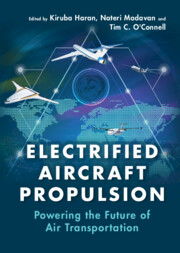Book contents
- Electrified Aircraft Propulsion
- Electrified Aircraft Propulsion
- Copyright page
- Dedication
- Contents
- Contributors
- Preface
- 1 Benefits of Electrified Propulsion for Large Aircraft
- 2 Aircraft Electric Power System Design, Control, and Protection
- 3 Megawatt-Scale Electric Machines for Electrified Aircraft Propulsion
- 4 Superconducting Machines and Cables
- 5 Conventional Power Electronics for Electrified Aircraft Propulsion
- 6 Cryogenic Power Electronics
- 7 Electrochemical Energy Storage and Conversion for Electrified Aircraft
- 8 Thermal Management of Electrified Propulsion Systems
- 9 Performance Assessment of Electrified Aircraft
- Index
- References
1 - Benefits of Electrified Propulsion for Large Aircraft
Published online by Cambridge University Press: 11 May 2022
- Electrified Aircraft Propulsion
- Electrified Aircraft Propulsion
- Copyright page
- Dedication
- Contents
- Contributors
- Preface
- 1 Benefits of Electrified Propulsion for Large Aircraft
- 2 Aircraft Electric Power System Design, Control, and Protection
- 3 Megawatt-Scale Electric Machines for Electrified Aircraft Propulsion
- 4 Superconducting Machines and Cables
- 5 Conventional Power Electronics for Electrified Aircraft Propulsion
- 6 Cryogenic Power Electronics
- 7 Electrochemical Energy Storage and Conversion for Electrified Aircraft
- 8 Thermal Management of Electrified Propulsion Systems
- 9 Performance Assessment of Electrified Aircraft
- Index
- References
Summary
The electrical systems in turboelectric and hybrid-electric aircraft provide unmatched flexibility, coupling the power turbines to the fan propulsors and facilitating tight propulsion system-airframe integration. Reduced noise, emissions, and fuel burn result. However, the associated weight and efficiency penalties offset these benefits. Luckily, studies have shown significant aerodynamic improvements from electrically sourcing a small fraction of propulsive power. Partially turboelectric and hybrid-electric propulsion systems provide an intermediate step between conventional turbofan and fully turboelectric or all-electric architectures. This chapter details the benefits of electrified propulsion for large aircraft, using numerous trade studies and analyses of concept vehicles. It presents a first-order breakeven analysis that reveals key electrical power system requirements, providing a framework for comparing electric drive system performance factors, such as electrical efficiency, in the context of electrified and traditional propulsion systems. This can guide electrical system component research and provide aircraft designers with rational component expectations.
Keywords
- Type
- Chapter
- Information
- Electrified Aircraft PropulsionPowering the Future of Air Transportation, pp. 1 - 28Publisher: Cambridge University PressPrint publication year: 2022

